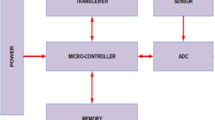Abstract
Due to link additions, small world phenomena exist in tree-based wireless sensor networks. Epidemics on small worlds of tree-based networks are studied, and the epidemic threshold at which the outbreak of the epidemic occurs is calculated. Epidemiological processes are analyzed when the infection probability is larger than the percolation threshold. Although different epidemiological processes occur on the underlying tree topology, the number of infected nodes increases exponentially as the infection spreads. The uniform immunization procedure is conducted in the homogeneous small-world network. The infection still extends exponentially although the immunization effectively reduces the prevalence speed.
Similar content being viewed by others
References
Alippi C, Camplani R, Galperti C, et al., A robust, adaptive, solar-powered WSN framework for aquatic environmental monitoring, IEEE Sensors Journal, 2011, 11(1): 45–55.
Wang X, Wang S, and Bi D W, Distributed visual-target-surveillance system in wireless sensor networks, IEEE Transactions on Systems, Man, and Cybernetics, Part B: Cybernetics, 2009, 39(5): 1134–1146.
Demirbas M, Lu X M, and Singla P, An in-network querying framework for wireless sensor networks, IEEE Transactions on Parallel and Distributed Systems, 2009, 20(8): 1202–1215.
Wong Y C, Wang J T, Chang N H, et al., Hybrid address configuration for tree-based wireless sensor networks, IEEE Communications Letters, 2008, 12(6): 414–416.
Zhu Y J, Vedantham R, Park S J, et al., A scalable correlation aware aggregation strategy for wireless sensor networks, Information Fusion, 2008, 9(3): 354–369.
Sanchez J A and Ruiz P M, Energy-efficient geographic multicast routing for error-prone wireless sensor networks, Wireless Communications and Mobile Computing Journal, 2009, 9(3): 395–404.
Shen H, Finding the k most vital edges with respect to minimum spanning tree, Acta Informatica, 1999, 36: 405–424.
Muruganathan S D, Ma D C F, Bhasin R I, et al., A centralized energy-efficient routing protocol for wireless sensor networks, IEEE Communications Magazine, 2005, 43(3): S8–13.
Wang W, Wang B W, Liu Z, et al., A cluster-based and tree-based power efficient data collection and aggregation protocol for wireless sensor networks, Information Technology Journal, 2011, 10(3): 557–564.
Yang Y, Zhu S C, and Cao G H, Improving sensor network immunity under worm attacks: A software diversity approach, Proceedings of the 9th ACM International Symposium on Mobile Ad Hoc Networking and Computing, 2008, 149–158.
De P, Liu Y, and Das S K, Modeling node compromise spread in wireless sensor networks using epidemic theory, International Symposium on a World of Wireless, Mobile and Multimedia Networks, 2006, 237–243.
Stanley M, The small world problem, Psychology Today, 1967, 2: 60–67.
Watts D J, Small worlds, the Dynamics of Networks Between Order and Randomness, Princeton University Press, New Jersey, 1999.
Li Q, Cui L G, Zhang B H, et al., Small worlds in the tree topologies of wireless sensor networks, Proceedings of the 29th Chinese Control Conference, 2010, 4677–4683.
Moore C and Newman M E J, Epidemics and percolation in small-world networks, Physical Review E, 2000, 61(5): 5678–5682.
Huang C Y and Tsai Y S, Effects of friend-making resources/costs and remembering on acquain tance networks, Physica A: Statistical Mechanics and Its Applications, 2010, 389(3): 604–622.
Walker D M, Allingham D, Lee H W J, et al., Parameter inference in small world network disease models with approximate Bayesian computational methods, Physica A: Statistical Mechanics and Its Applications, 2010, 389(3): 540–548.
Telo da Gama M M, and Nunes A, Epidemics in small world networks, The European Physical Journal B, 2006, 50: 205–208.
Litvak-Hinenzon A and Stone L, Spatio-temporal waves and targeted vaccination in recurrent epidemic network models, Journal of the Royal Society, 2009, 6(38): 749–760.
Thomas E S, Matthew M J, and Susan R M, Comparative effects of avoidance and vaccination in disease spread on a dynamic small-world network, Physica A: Statistical Mechanics and Its Applications, 2010, 389(23): 5515–5520.
Yu X L, Wang X Y, Zhang D M, et al., Mathematical expressions for epidemics and immunization in small-world networks, Physica A: Statistical Mechanics and Its Applications, 2008, 387(5–6): 1421–1430.
Stone T E, Jones M M, and Mckey S R, Comparative effects of avoidance and vaccination in disease spread on a dynamic small-world network, Physica A: Statistical Mechanics and Its Applications, 2010, 389(23): 5515–5520.
Dietrich S and Ammon A, Introduction to Percolation Theory, Burgess Science Press, Great Britain, 1992.
Alon N and Spencer J H, The Probabilistic Method, John Wiley, California, 2000.
Lindsey S, Raqhavendra C, and Sivalinqam K M, Data gathering algorithms in sensor networks using energy metrics, IEEE Transactions on Parallel and Distributed Systems, 2002, 13(9): 924–935.
Tang F L, You L, Guo S, et al., A chain-cluster based routing algorithm for wireless sensor networks, Journal of Intelligent Manufacturing, 2012, 23(4): 1305–1313.
Pal S, Debnath B, and Kim T H, Chain based hierarchical routing protocol for wireless sensor networks, Communications in Computer and Information Science, 2010, 78: 482–492.
Norman T J, The Mathematical Theory of Infectious Diseases, Hafner Press, New York, 1975.
Author information
Authors and Affiliations
Corresponding author
Additional information
This research is supported by the National Natural Science Foundation of China under Grant No. 61203144, the General Financial Grant from the China Postdoctoral Science Foundation under Grant No. 2013M540869, and the Open Fund of Guangdong Provincial Digital Signal and Image Processing Technologies Key Laboratory under Grant No. 2013GDDSIPL-06.
This paper was recommended for publication by Editor WANG Xiaofan.
Rights and permissions
About this article
Cite this article
Li, Q., Zhang, B., Cui, L. et al. Epidemics on small worlds of tree-based wireless sensor networks. J Syst Sci Complex 27, 1095–1120 (2014). https://doi.org/10.1007/s11424-014-1178-1
Received:
Revised:
Published:
Issue Date:
DOI: https://doi.org/10.1007/s11424-014-1178-1




